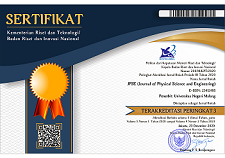Distance Variation of Light Source Effects toward Dye Sensitized Solar Cell (DSSC) Performance using Anthocyanin Extract from Rosella Flower
Abstract
This study aims to determine the characteristics of DSSC using rosella flower extracts with variations in the distance of the light source to DSSC. The characteristics measured are current and voltage values and cell efficiency. A 150-watt halogen lamp is used as the light source. Light source was placed at a distance of 10 cm, 20 cm, and 30 cm. The voltage and current value of the halogen lamp with a distance of 10 cm to DSSC are greater than the distance of 20 cm and 30 cm. The test results show that the cell efficiency of 10 cm to DSSC is the most maximum with current (Imax) of 0.08 mA, maximum voltage (Vmax) of 306.7 mV and the efficiency of 0.046%. The smaller the distance of the halogen lamp to DSSC increases the intensity of the light so that the greater the DSSC output value.
Keywords
Full Text:
PDFReferences
K. H. Park, S.J. Kim, R. Gomes, and A. Bhaumik, (2015), High Performance Dye-Sensitized Solar Cell by Using Porous Polyaniline Nanotube as Counter Electrode, Chem. Eng. J., vol 260, pp 393-398.
H.M. Upadhyaya, S. Senthilarasu, M. H.Hsu, and D. K. Kumar, (2013), Recent Progress and The Status of Dye-Sensitized Sola Cell (DSSC) Technology with State-of-The-Art Convertion Efficiencies, Sol Energy Mater. Sol. Cell, vol. 119, ppp 291-295.
B. O’regan and M. Grätzel, (1991), A low-cost, high-efficiency solar cell based on dye-sensitized
colloidal TiO2 films, Nature, vol. 353, no. 6346, pp. 737–740.
M. Grätzel, (2003), Dye-sensitized solar cells, J. Photochem. Photobiol. C Photochem. Rev., vol. 4, no. 2, pp. 145–153.
Y. Shi et al., (2013), Solid-State Synthesis of ZnO Nanostructures for Quasi-Solid Dye-Sensitized
Solar Cells with High Efficiencies up to 6.46%,” Adv. Mater., vol. 25, no. 32, pp. 4413–4419.
H.-R. An, H. An, D.-H. Riu, and H.-J. Ahn, (2015), Improved Photovoltaic Properties Of Dye- Sensitized Solar Cells Using Laser Patterned F-Doped SnO2 Thin Films, Arch. Metall. Mater., vol. 60, no. 2, pp. 1241–1245.
A. A. Khan, J. Islam, S. G. Ansari, H. Fouad, and Z. A. Ansari (2015), Effect of neodymium on the photoconversion efficiency of TiO2 based dye sensitized solar cells, J. Mater. Sci. Mater. Electron., vol. 26, no. 3, pp. 1737–1742.
K.-N. Li, Y.-F. Wang, Y.-F. Xu, H.-Y. Chen, C.-Y. Su, and D.-B. Kuang, (2013), Macroporous SnO2 Synthesized via a Template-Assisted Reflux Process for Efficient Dye-Sensitized Solar Cells,
ACS Ar. Interfacesppl. Mate, vol. 5, no. 11, pp. 5105–5111.
M. R. Narayan, (2012), Review: Dye Sensitized Solar Cells Based On Natural Photosensitizers, Renew. Sustain. Energy Rev., vol. 16, no. 1, pp. 208–215.
R. Suryana, Khoiruddin, and A. Supriyanto, (2013), Beta-carotene Dye of Daucus Carota as Sensitizer on Dye-Sensitized Solar Cell, Mater. Sci. Forum, vol. 737, pp. 15-19.
Kumara, M. dan Prajitno, G, (2012), Studi Awal Fabrikasi Dye Sensitized Solar Cell (DSSC) dengan Menggunakan Ekstraksi Daun Bayam (Amaranthus Hybridus L.) sebagai Dye Sensitizer dengan Variasi Jarak Sumber Cahaya Pada Dssc, Jurusan Fisika Institut Teknologi Sepuluh November (ITS).
K. Wongcharee, V. Meeyoo, and S. Chavadej, (2007). Dye-sensitized solar cell using natural dyes extracted from rosella and blue pea flowers, Solar Energy Materials and Solar Cells, 91, 7, 566-571. http://dx.doi.org/10.1016/j.solmat.2006.11.005.
L. Okoli, JO Ozuomba, AJ Ekpunobi, PI Ekwo, (2012), Anthocyanin-dyed TiO2 electrode and its performance on dye-sensitized solar cell, Research Journal of Recent Sciences, vol. 1, pp. 22-27.
Adhitya, E.A, (2013), Sintesa Titanium dioxide (TiO2) untuk Dye-Sensitized Solar Cell dengan Antosianin Bunga Rosella (Hibiscus sabdariffa), Indonesian Journal of Applied Physics vol. No.2 Hal. 181-187.
M. Artono, (2013), Fabrikasi Dye sensitized Solar Cell Menggunakan Natural Dye sebagai Alternatif Dye Ruthenium, Program StudiTeknik Fisika Fakultas Teknologi Industri ITB, Bandung.
Mustaqim, Haris, A., dan Gunawan, (2017), Fabrikasi Dye-Sensitized Solar Cell Menggunakan Fotosensitizer Ekstrak Bunga Rosela (Hibiscus sabdariffa L) dan Elektrolit Padat Berbasis PEG (Polyethylene Glycol). Jurnal Kimia Sains dan Aplikasi vol. 20 no. 2 hal 62-67.
Mardiah, (2010), Ekstraksi Kelopak Bunga dan Batang Ekstraksi Kelopak Bunga dan Batang Rosella (Hibiscus Sabdariffa L.) sebagai Pewarna Merah Alami, Jurusan Teknologi Pangan dan Gizi Universitas Djuanda, Bogor.
Septina, W., D Fajarisandi, M Aditia, (2007), Pembuatan Prototipe Solar Cell Murah dengan Bahan Organik-Inorganik (Dye-sensitized Solar Cell), in: Laporan Akhir Penelitian Bidang Energi, Penghargaan PT. Rekayasa Industri.
Wiwin Supiyanti, E Dwi Wulansari, L Kusmita, (2010), Uji aktivitas antioksidan dan penentuan kandungan antosianin total kulit buah manggis (Garcinia mangostana L), Majalah Obat Tradisional, Vol.15, No 2, hal.64-70.
Monica Jordheim, Isolation, Identification and Properties of Pyranoanthocyanins and Anthocyanin Forms, Department of Chemistry, The University of Bergen, Norway.
Maddu, A., (2007), Penggunaan Ekstrak Antosianin Kol Merah Sebagai Fotosentizer Pada Sel Surya TiO2 Nanokristal Tersentisasi Dye (Departemen Fisika FMIPA, Institut Pertanian Bogor.
Copyright (c) 2020 Rafika Andari

This work is licensed under a Creative Commons Attribution-ShareAlike 4.0 International License.
This work is licensed under a Creative Commons Attribution-ShareAlike 4.0 International License



















